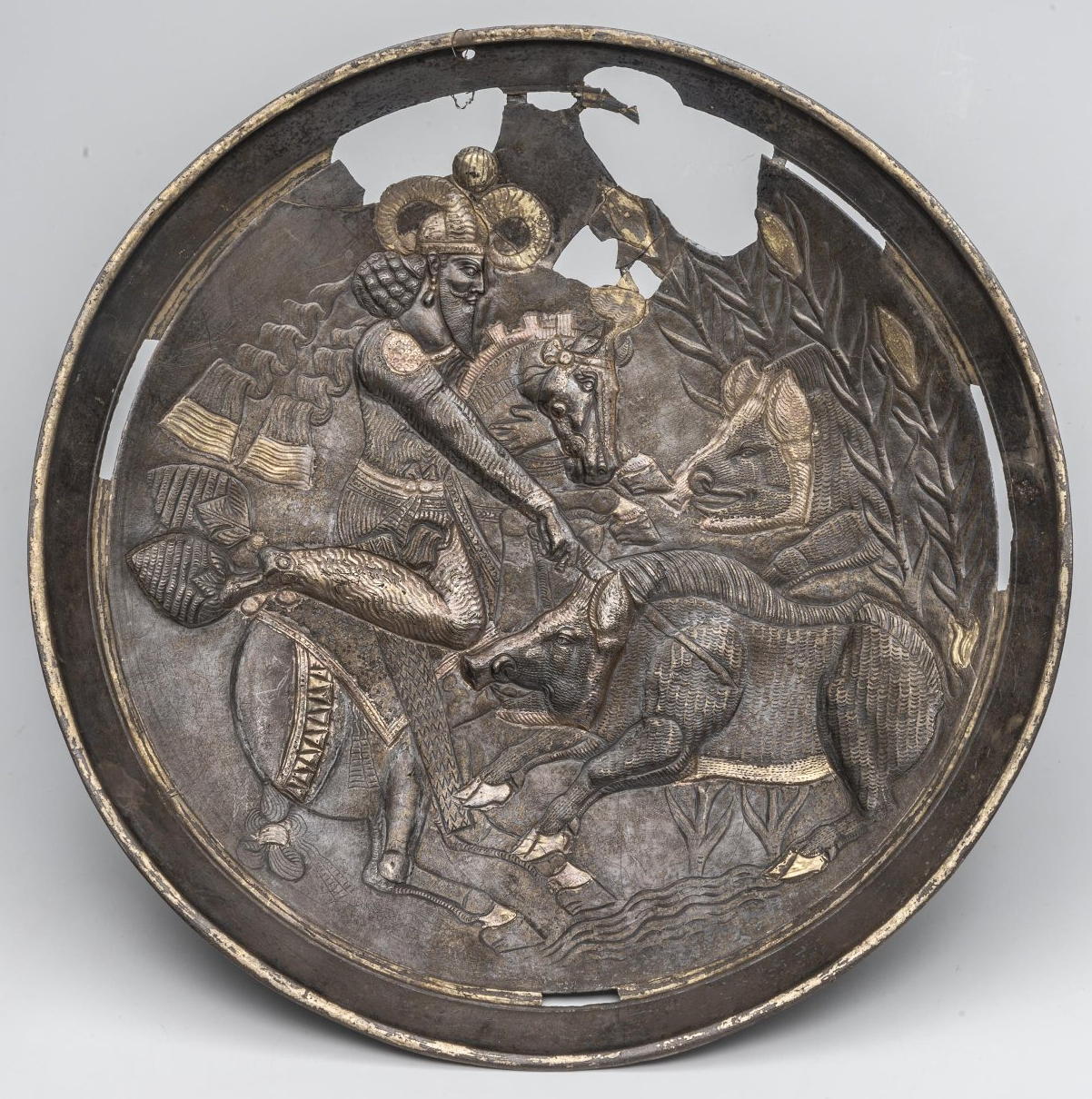Boar Hunt. Kushano-Sasanian silver gilt plate

Plate with Bahram II out on a Hunt
Title: Plate with Bahram II out on a Hunt
Place: Iran
Date: late 4th – early 5th century
Place of origin: Russia, as part of a hoard in Perm province, 1893
Epoch. Period: The Sassanid Empire (224-651)
Material: silver
Technique: chasing, gilding
Dimensions: diameter: 27,6 cm
Museum number: S-24
Acquisition details: Entered the Hermitage in 1894; transferred from the Imperial Archaeological Commission
Category: Applied Arts
Collection: Oriental Art
Subcollection: Iran
Source: Hermitage Museum
Dish depicting Varakhran hunting.
390-420s CE. Silver. Dia. 27.6-28 cm.
Sogdian inscr. Samarkand script: "Lord Shav of Chach, i.e. Chach land. 39 staters."
Found 1893 vill. of Kerchevoe, Cherdyn u., Perm prov. Acq. 1894 from Archaeological Commission; Inv. no. S-24.
Pub.: Smirnov no. 53; Trever and Lukonin no. 7
State Hermitage Museum, St. Petersburg :: Sasanian Metalwork. washington.edu
Another plate belonging to this group is in the Hermitage Museum (Pl. 23).44
On it the figure of a king wearing a horned crown appears. Because of this headdress the plate has been variously dated by those who argue in favor of one or another chronology for the coins of the Kushano-Sasanians and later Kidarites (rulers in the region of present-day Afghanistan) on which a similar horned headdress is worn by royal figures.45
The striated globe above the head of the hunter on the silver plate is an additional detail linking this work to the images on these coins.
It is a perfectly circular form, the surface of which has vertical lines.
Viewed apart from the controversy surrounding the dating of Kushan coins, and instead in the light of the development traced above for the medallion bowls, the figure on the Hermitage plate is closer to the stage reached on the
Cincinnati bowl (Pl. 3)
than to that on the Metropolitan Museum bowl with a male bust (Pl. 6)
or the British Museum's hunting plate (Pl. 13).
This is apparent in the rather fine and careful treatment of the hair curls and mustache, the almost full-front view of the eye, and the form of the folds in the drapery-irregular crescentic lines, the ends of which turn out toward the folds of the drapery on the chest.
The chest folds ripple vertically over the body more schematically than on the Cincinnati bowl but in a similar fashion.
In contrast, the figures on the vessels in the Metropolitan Museum and the British Museum (Pls. 6, 13) wear drapery on which a series of crescents runs vertically down the center of the chest, and on both sides the folds are depicted as straight or slightly curving parallel lines.
The stylization of the drapery has become rigidly geometric. The provenance of the Hermitage plate is the Perm, but the original place of manufacture is unknown.
It is not impossible that this is a provincial work, following the Sasanian style of the Cincinnati bowl but actually made in the Kushan East.46
The formal and stylistic development of such Eastern works could lag behind the artistic production in Iran.
In comparison with Iranian works, however, the Hermitage plate should fall at the end of the third or beginning of the fourth century A.D.
44. Orbeli and Trever, Sas. Metall, pl. 4. Smirnov, Serebro, pl. 25, no. 53. See Chapter III, pp. 72 ff.
45. This plate has been variously attributed to Bahram I and II, Shapur II and III.
A list of these attributions and full bibliography appears in Negro Ponzi, "Some Sasanian Moulds," p. 77.
A recent suggestion that this is Bahram, son of Bahram IV, who begins his reign as Kushanshah in 388, is in Marshak and Krikis, "Chilekskie Chashi," p. 63.
Lukonin notes the similarity between this plate and that in the British Museum showing Shapur II stabbing a stag (Pl. 13) in "Kush.-Sas. monety," p. 22.
On pp. 30-31 of the same article Lukonin discusses the horned crown on the coins and gives bibliography.
46. Maenchen-Helfen, "Crenelated Mane," p. 112. He attributes the plate to Bahram I or II. See Chapter V, pp. 133 ff.
pp. 36-37, Silver Vessels of the Sasanian Period. Vol. 1, Royal Imagery, by Harper, Prudence O., and Pieter Meyers
See also Sassanid Rock Relief of Bahram II at Naqsh-i Rustam
Back to Figures on Sasanian and Central Asian Plates

